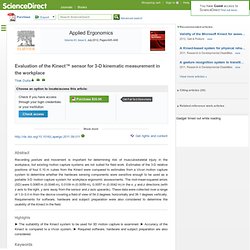

Microsoft Kinect for Windows. I Heart Robotics: Limitations of the Kinect. Or "Why do we still need other sensors if the Kinect is so awesome?

" The Kinect is a great sensor and a game changer for mobile robotics, but it won't make every other sensor obsolete. Though maybe I can use it to convince someone to let me take apart a Swiss Ranger 4000. Field of View The field of view is an important consideration for sensors because if you can't see enough features you can't use scan matching/ICP to estimate your change in position. Imagine if you were in a giant white room with only one wall that was perfectly flat. if you walk along the wall there is no way to determine your movement except from how many steps you take. The depth image on the Kinect has a field of view of 57.8°, whereas the Hokuyo lasers have between 240° and 270°, and the Neato XV-11's LIDAR has a full 360° view.
In addition to being able to view more features, the wider field of view also allows the robot to efficiently build a map without holes. Range Environmental Computation and Thermodynamics. Applied Ergonomics - Evaluation of the Kinect™ sensor for 3-D kinematic measurement in the workplace. Abstract Recording posture and movement is important for determining risk of musculoskeletal injury in the workplace, but existing motion capture systems are not suited for field work.

Estimates of the 3-D relative positions of four 0.10 m cubes from the Kinect were compared to estimates from a Vicon motion capture system to determine whether the hardware sensing components were sensitive enough to be used as a portable 3-D motion capture system for workplace ergonomic assessments. The root-mean-squared errors (SD) were 0.0065 m (0.0048 m), 0.0109 m (0.0059 m), 0.0057 m (0.0042 m) in the x, y and z directions (with x axis to the right, y axis away from the sensor and z axis upwards).
These data were collected over a range of 1.0–3.0 m from the device covering a field of view of 54.0 degrees horizontally and 39.1 degrees vertically. Requirements for software, hardware and subject preparation were also considered to determine the usability of the Kinect in the field. Highlights Keywords. Skeletal Tracking. Kinect for Windows 1.5, 1.6, 1.7, 1.8 Skeletal Tracking allows Kinect to recognize people and follow their actions.
Using the infrared (IR) camera, Kinect can recognize up to six users in the field of view of the sensor. Of these, up to two users can be tracked in detail. An application can locate the joints of the tracked users in space and track their movements over time. Figure 1. Skeletal Tracking is optimized to recognize users standing or sitting, and facing the Kinect; sideways poses provide some challenges regarding the part of the user that is not visible to the sensor. To be recognized, users simply need to be in front of the sensor, making sure the sensor can see their head and upper body; no specific pose or calibration action needs to be taken for a user to be tracked. Figure 2. Kinect field of view of the users is determined by the settings of the IR camera, which are set with the DepthRange Enumeration.
Kinect Color - Depth Camera Calibration. Url?sa=t&rct=j&q=&esrc=s&source=video&cd=3&ved=0CEAQtwIwAg&url=http%3A%2F%2Fwww.youtube. Report: Here Are Kinect's Technical Specs.